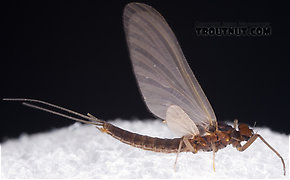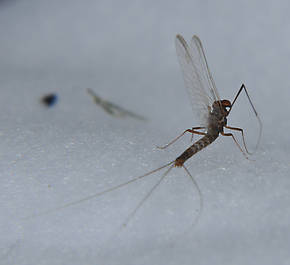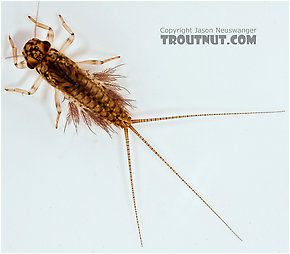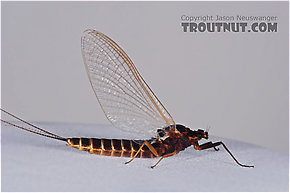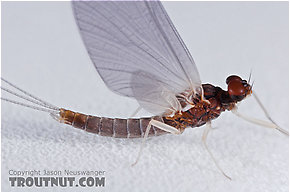Blog & Latest Updates
Fly Fishing Articles
Insects by Common Name


Blue Duns
Scientific Names
Like most common names, "Blue Dun" can refer to more than one taxon. They're previewed below, along with 10 specimens. For more detail click through to the scientific names.
Mayfly Species Neoleptophlebia adoptiva
These are very rarely called Blue Duns.
This is the best Spring hatch after the Quill Gordons (Epeorus pleuralis) but before the Hendricksons (Ephemerella subvaria) in most parts of the East, although it can overlap with both. The Blue Quills are small mayflies (hook size 16-20) but they can hatch in incredible numbers at a time when eager trout are just beginning to look to the surface after a hungry winter.
Male Neoleptophlebia adoptiva (Blue Quill) Mayfly Spinner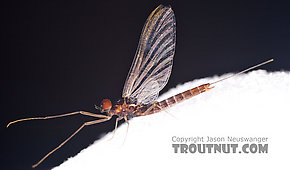 View 7 PicturesBased on the pale longitudinal forewing veins (excepting the costals), dark middle terga (Tergum: the dorsal part of an abdominal segment or segments (terga). Also used to describe the entire abdominal dorsum or the thoracic dorsal segments of Odonata.), and genitalia (Burks '53), this specimen is P. adoptiva.
View 7 PicturesBased on the pale longitudinal forewing veins (excepting the costals), dark middle terga (Tergum: the dorsal part of an abdominal segment or segments (terga). Also used to describe the entire abdominal dorsum or the thoracic dorsal segments of Odonata.), and genitalia (Burks '53), this specimen is P. adoptiva.
 View 7 PicturesBased on the pale longitudinal forewing veins (excepting the costals), dark middle terga (Tergum: the dorsal part of an abdominal segment or segments (terga). Also used to describe the entire abdominal dorsum or the thoracic dorsal segments of Odonata.), and genitalia (Burks '53), this specimen is P. adoptiva.
View 7 PicturesBased on the pale longitudinal forewing veins (excepting the costals), dark middle terga (Tergum: the dorsal part of an abdominal segment or segments (terga). Also used to describe the entire abdominal dorsum or the thoracic dorsal segments of Odonata.), and genitalia (Burks '53), this specimen is P. adoptiva.Mayfly Species Paraleptophlebia bicornuta
These are very rarely called Blue Duns.
This important Western species is one of the few mayflies outside the Ephemeridae family to possess large tusks on the front of its head. It is also one of the largest species of Paraleptophlebia.
P. bicornuta is often reinforced by simultaneous hatches of the more common Paraleptophlebia debilis. The two duns appear virtually identical to the naked eye, though bicornuta usually has an edge in size.
Paraleptophlebia bicornuta is by far the widest distributed tusked species, though there are others. Telling the tusked species apart is very difficult and even entomological texts are largely ambiguous on the characters that differentiate them. Distribution records are probably the most reliable way for anglers to know with any probability what they are looking at. Check out the Paraleptophlebia packii and Paraleptophlebia helena hatch pages for more distribution information.
P. bicornuta is often reinforced by simultaneous hatches of the more common Paraleptophlebia debilis. The two duns appear virtually identical to the naked eye, though bicornuta usually has an edge in size.
Paraleptophlebia bicornuta is by far the widest distributed tusked species, though there are others. Telling the tusked species apart is very difficult and even entomological texts are largely ambiguous on the characters that differentiate them. Distribution records are probably the most reliable way for anglers to know with any probability what they are looking at. Check out the Paraleptophlebia packii and Paraleptophlebia helena hatch pages for more distribution information.
Paraleptophlebia bicornuta (Mahogany Dun) Mayfly Nymph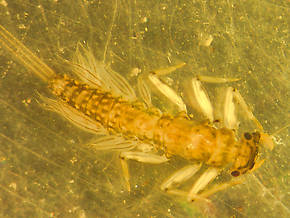 View 1 PicturesThis species is interesting because it is common in lakes as well as streams. It is one of the last species of the year to emerge in western Montana. Adults have been collected as late as October 15 weather permitting.
View 1 PicturesThis species is interesting because it is common in lakes as well as streams. It is one of the last species of the year to emerge in western Montana. Adults have been collected as late as October 15 weather permitting.
 View 1 PicturesThis species is interesting because it is common in lakes as well as streams. It is one of the last species of the year to emerge in western Montana. Adults have been collected as late as October 15 weather permitting.
View 1 PicturesThis species is interesting because it is common in lakes as well as streams. It is one of the last species of the year to emerge in western Montana. Adults have been collected as late as October 15 weather permitting.Male Paraleptophlebia bicornuta (Mahogany Dun) Mayfly Dun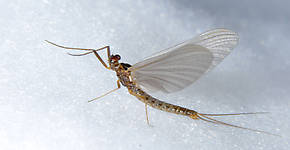 View 1 PicturesYou wonder sometimes how certain insects get their common names. This one is called the 'mahogany dun' for some unknown reason.
View 1 PicturesYou wonder sometimes how certain insects get their common names. This one is called the 'mahogany dun' for some unknown reason.
 View 1 PicturesYou wonder sometimes how certain insects get their common names. This one is called the 'mahogany dun' for some unknown reason.
View 1 PicturesYou wonder sometimes how certain insects get their common names. This one is called the 'mahogany dun' for some unknown reason.See 2 more specimens...
Mayfly Species Leptophlebia cupida
These are very rarely called Blue Duns.
Most anglers encounter these large mayflies every Spring in the East and Midwest. They are omnipresent in small portions, providing filler action in the days or hours between the prolific hatches of the early season Ephemerella flies.
See the main Leptophlebia page for details about their nymphs, hatching, and egg-laying behavior. This is by far the most important species of that genus.
See the main Leptophlebia page for details about their nymphs, hatching, and egg-laying behavior. This is by far the most important species of that genus.
Male Leptophlebia cupida (Borcher Drake) Mayfly Dun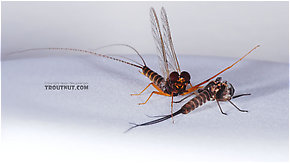 View 6 PicturesThis Leptophlebia cupida dun was extremely cooperative, and it molted into a spinner for me in front of the camera. Here I have a few dun pictures and one spinner picture, and I've put the entire molting sequence in an article.
View 6 PicturesThis Leptophlebia cupida dun was extremely cooperative, and it molted into a spinner for me in front of the camera. Here I have a few dun pictures and one spinner picture, and I've put the entire molting sequence in an article.
 View 6 PicturesThis Leptophlebia cupida dun was extremely cooperative, and it molted into a spinner for me in front of the camera. Here I have a few dun pictures and one spinner picture, and I've put the entire molting sequence in an article.
View 6 PicturesThis Leptophlebia cupida dun was extremely cooperative, and it molted into a spinner for me in front of the camera. Here I have a few dun pictures and one spinner picture, and I've put the entire molting sequence in an article.See 14 more specimens...
Mayfly Species Paraleptophlebia debilis
These are very rarely called Blue Duns.
This widespread species can produce memorable hatches where it is locally abundant, especially in the West where it also tends to run larger in size. It loves the margins as is typical of most Leptophlebiidae species but has a greater tolerance for current. They are often found even in riffles. This is the most important species in the West.
Female Paraleptophlebia debilis (Mahogany Dun) Mayfly Dun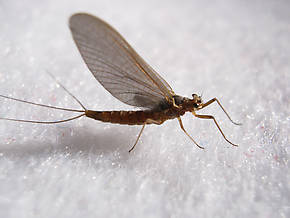 View 3 PicturesSize: 9mm. These photos really highlight the brown pigmentation of the wing venation (Venation: The pattern in which the veins on the wings of an insect are arranged. It is usually one of the most useful identifying characteristics.), but in the hand the wings look to be a uniform smokey gray. - Entoman
View 3 PicturesSize: 9mm. These photos really highlight the brown pigmentation of the wing venation (Venation: The pattern in which the veins on the wings of an insect are arranged. It is usually one of the most useful identifying characteristics.), but in the hand the wings look to be a uniform smokey gray. - Entoman
 View 3 PicturesSize: 9mm. These photos really highlight the brown pigmentation of the wing venation (Venation: The pattern in which the veins on the wings of an insect are arranged. It is usually one of the most useful identifying characteristics.), but in the hand the wings look to be a uniform smokey gray. - Entoman
View 3 PicturesSize: 9mm. These photos really highlight the brown pigmentation of the wing venation (Venation: The pattern in which the veins on the wings of an insect are arranged. It is usually one of the most useful identifying characteristics.), but in the hand the wings look to be a uniform smokey gray. - EntomanMayfly Species Leptophlebia johnsoni
These are very rarely called Blue Duns.
Mayfly Species Neoleptophlebia mollis
These are very rarely called Blue Duns.
This species often emerges together with Paraleptophlebia strigula and Paraleptophlebia guttata, and the combined effect can be a good fishable hatch. The latter two are much less famous than mollis, but Knopp and Cormier say they are more reliable.
Top 10 Fly Hatches
Top Gift Shop Designs
Eat mayflies.
Top Insect Specimens
Miscellaneous Sites
Troutnut.com is copyright © 2004-2024 Jason
Neuswanger (email Jason). See my FAQ for information about use of my images.
 privacy policy
privacy policy

